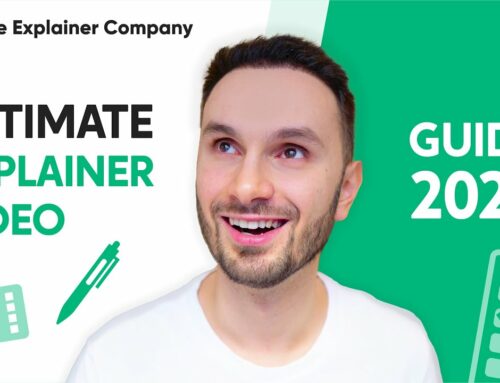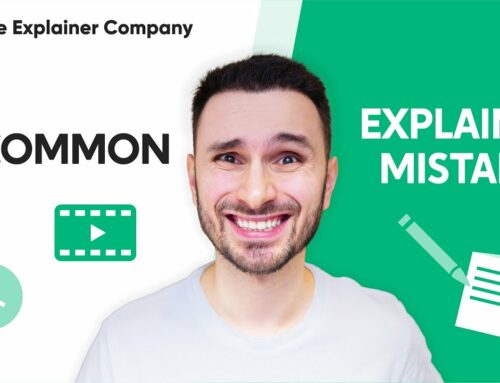In this article, I will present to you the 4-step “Classic Explainer Video” scriptwriting formula.
And don’t take this the wrong way, it’s not called classic because it’s outdated or anything like that.
It’s actually so good, that almost all great explainer videos out there, use some form or variation of this formula.
If you’re not aware of this or are not using the simple steps, you’re just missing out on a lot of video engagement.
Because there’s a method to the madness and if you don’t follow it, most people will just stop watching your video because you’re just not taking them through the correct steps of their journey.
So, let’s get straight to it!
Now of course, scriptwriting and copywriting, in general, are way more complex than this and you’re not gonna be able to become world-class after reading one short article.
The point of this “classic explainer video” script formula is to give you an introduction and a framework that you can use to get started.
Think of it as a crash course that will make your video scripts better than most videos out there.
Alright, so basically almost all great explainer videos can be boiled down to those 4 simple steps:
Step 1 – The problem
Here’s where you introduce the problem and you show that you know what the viewers are going through
Step 2 – The solution
This is where you introduce your product or service as the magic solution
Step 3 – How it works
People are not going to just blindly trust you that you can help, you need to demonstrate how you’re going to address their problem and solve it for them.
And last but not least, is Step 4 – the call to action
Tell the viewer what to do next!
You think you can follow that as well? Alright, let’s dive a little bit deeper into each one!
Step #1 – The Problem
I would argue that this is probably the most important part of the video
The reason for that is that people don’t usually buy something to seek pleasure, they do it to avoid pain.
Pain is the greatest motivator. It’s pretty silly, but that’s how it works. For example, I used to play basketball competitively, and sure, I definitely enjoyed winning, but there was one thing even stronger than that driving me to train hard. I absolutely hated losing.
In this part of the video, you wanna introduce the problem to demonstrate empathy with the viewer’s suffering. What this does is it makes the viewer relate to the problem and say:
“Oh, that’s exactly my problem!”
Or
“That’s exactly what I’m going through right now, how did you know?”
Of course, all of this is subconscious, but this way they feel compelled to keep watching the video. Because now, the video is about them. Because they wanna stop having that problem.
It’s simple. If you started straight away and said something like:
“Hey, we got this WordPress plugin… and it does this and that and secures your website”
Nobody really cares what you do straight away. Really! And let that sink in for a second. Unless there’s something in it for them, people are not gonna keep watching your video if all you talk about is you, your products, your services… they’re not gonna relate to that.
Another reason why this is so powerful is that it establishes you as an authority in the field.
Why?
Because only an expert in a certain area is gonna know exactly what the viewer is going through and what sort of problems they have. This adds a lot of bonus points to your credibility.
Because we wanna buy something from someone who knows exactly what they’re doing and what they’re talking about. More specifically, experts or authority figures, or established brands.
Step #2 – The Magic Solution!
All human beings want the shortcut, the instant solution to their problems. But life is not that black and white and of course, the devil is in the details.
After agitating the problem long enough and covering all the various pain points, it’s time to bring the solution. It’s basically like an emotional rollercoaster.
“But what if there was a simple solution where you didn’t have to count calories or stay away from your favourite foods?”
First, you go down and things are looking pretty bad, it’s dark and gloomy. But then there’s hope!
But you don’t just reveal the solution straight away. If possible, first you tease the solution.
And one way to do this is you talk about other solutions and how even those aren’t actually the right option for you right now.
“You probably tried all the diets in the world and you still couldn’t lose weight!”
Actually, if you do this right, you wanna frame this as this is the only solution to their problem. And to do that you have to know that people are guided by a lot of cognitive fallacies, flaws in our reasoning, and patterns of thinking that are not based on reason, but on other deep and ingrained emotions such as fear or the need for security
So one of the things that people still fall for, and I still do as well, is the cognitive fallacy of polarised thinking. In other words, we place people or persons in two categories: either / or. Us vs them. Your solution versus all other solutions.
With absolutely no shades of grey allowing for the complexity of most situations and people.
So when we start introducing the solution, we want it to sound like the actual real solution to their problems, not the “maybe this will work solution”
Because working with you has to be the simple, magical solution to their problems.
Step #3 – How It Works
Here’s the thing, at this point the viewer is fairly invested in your idea. But they’re not sold on it yet, so let’s do that. People wanna know how things are done and they wanna understand how you will solve their problems for them.
So… tell them! Lead them through the process, a simplified process of course. Bonus points if you can actually get it down to just 3 steps. As human beings we just love to simplify things in 3 simple steps, for whatever reason, it simply works, 3 is a magic number.
But here’s the point, it doesn’t matter if what you do is super complex and it actually takes 17 steps to go through what you do. At this point, it’s just an overview, so there’s no need to go into that many details.
So if you do something that’s very complex, just oversimplify it into 3 simple steps
Such as…
Step 1 – Reach out to a specialist to see how we can improve your website.
Step 2 – We’ll do an in-depth SEO audit.
Step 3 – We’ll personally help you implement all of our findings so that you can rank #1 on Google.
Something along those lines. The how-to is intended to reaffirm the easiness that you are gonna bring into their lives. So don’t make it complex, make it easy!
Step #4 – Call To Action
And last, but not least, Step 4 – super, super important: the call to action
When people know that you are talking to them, when you can solve their problems, that you can make it easy for them and it will fulfil their emotional needs, it’s time to take action.
But you have to understand one thing, people like to be told what to do next, especially online. You can’t just expect them to act on their own and do exactly the thing that you want them to do.
A lot of people actually skip the call to action, which is very, very bad for their video. You have to sit and think about your call to action quite a lot. Because people don’t just buy a product straight away, unless it’s something they really need or were actually looking for at that particular moment.
And an explainer video is just a small piece of content, usually around 1 to 2 minutes in length. And it’s very hard to get a direct sale straight from the explainer video.
So a hard call to action such as “Buy Now!” is unlikely to work. An explainer video is there to create some awareness, build some interest for the viewer to spend more time finding out more about your product or company in order to reach a buying decision.
Just like closing a sale in real life, an explainer video is just the first part of the interaction, you have to build a relationship. If you invite a girl out on a date, it’s a little bit awkward if you ask her to marry you after 5 minutes.
When you invite them to schedule a free demo, read more on your website, download a white paper or start a free trial, they will trust you more. Because you’re not instantly trying to sell them, you’re just providing value.
Alright, I hope you found this article useful. It’s a very good foundation for your next explainer video script and it’s a classic formula that you simply cannot go wrong with.
And here’s our call to action for the end of this article. Actually, two things, depending on where you wanna go next.
To find out more, check out our entire Explainer Series on YouTube for free or check out our blog Explainer Guides where we go even deeper and cover everything related to Explainer Videos.
And if you want to get an amazing explainer video for your company to stand out from all the noise, produced by a professional and experienced team with over 10+ years in the industry and more than 400+ videos produced for clients all over the world, then browse our website, check out our portfolio and get in touch!



